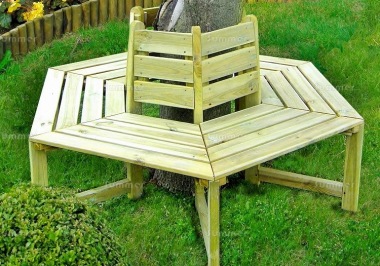Click this messge to hide it.
- Pressure treated pine throughout (lifetime preservative treatment)
- Timber sizes are nominal i.e. before machining, unless described as finished size
- All timber used in the construction of this garden bench originates from sustainable forests in Northern Europe
- Strong legs 70x33mm (finished size)
- Seat height approximately 1'5" (420mm)
- Overall seat width 5'3" (1600mm)
- Overall seat depth 4'7" (1385mm)
- Overall height 2'7" (800mm)
- Maximum tree diameter approximately 1'7" (500mm)
PRESSURE TREATED TIMBER: Pressure treatment is a lifetime preservative treatment. The preservative is forced deep into the timber under pressure in a vacuum and penetrates below the surface. All other treatments apply a coat of stain to the surface of the timber only. With pressure impregnated timber, the chemicals are permanently bonded to the cell structure of the wood at a molecular level. Tanalith E is a widely used water based version so pressure treated wood is often described as tanalised. Pressure treated wood is almost colourless except for a slight green tint caused by the copper content in the preservative. No further preservative treatment is ever needed. However, if you want a coloured finish you can paint over pressure treated or tanalised wood with a suitable wood preservative in any colour.
SAFETY: This product should be placed on a flat, level and hard base. Concrete and paving are ideal, lawns are too soft. Children should not be allowed to climb on this product or to play around it without adult supervision. Jumping on this product is not recommended. Adults should sit down without excessive force. During the winter months and periods of adverse weather we recommend covering this product or storing it under cover.
HEXAGONAL SIZES: For ease of reference this hexagonal seat is measured as a rectangle. The first dimension listed is the overall width from side to side and the second dimension is the depth from front to back. The overall width is measured at the widest point from corner to corner and the depth is measured at the narrowest point. All sizes are approximate.





